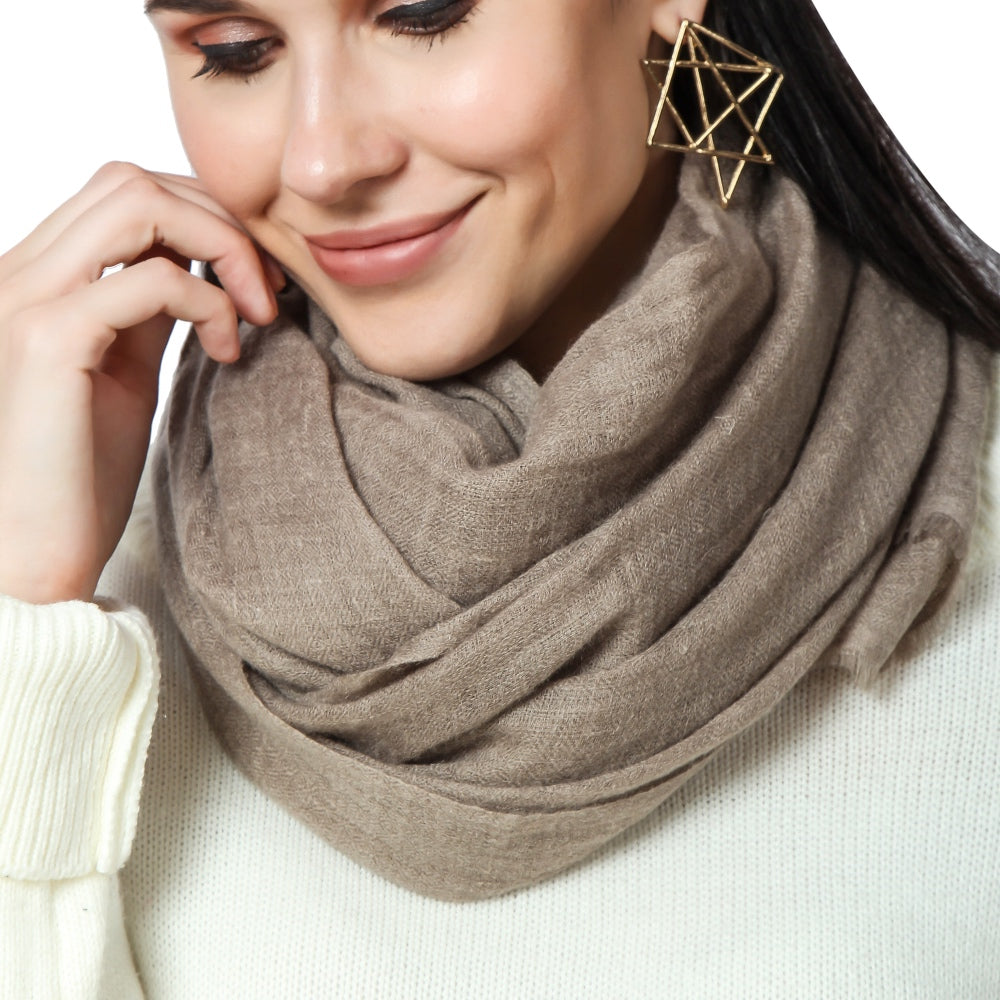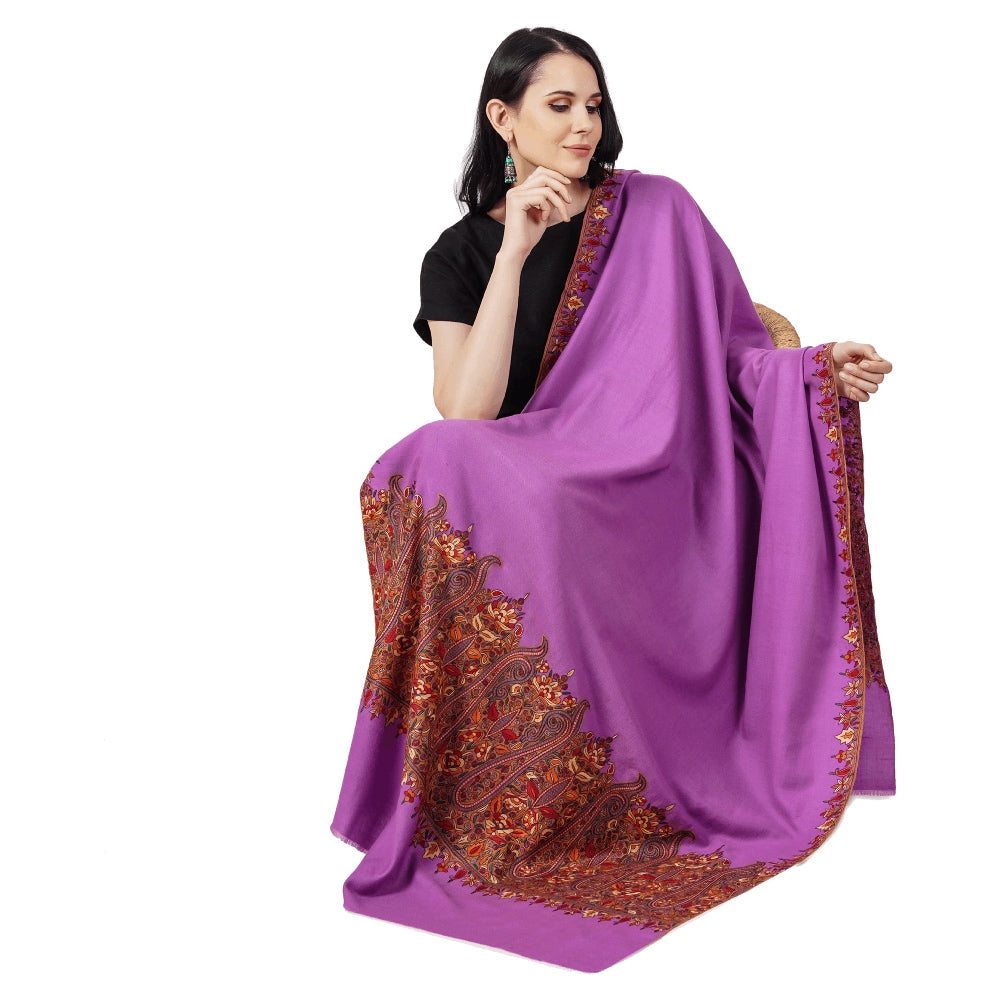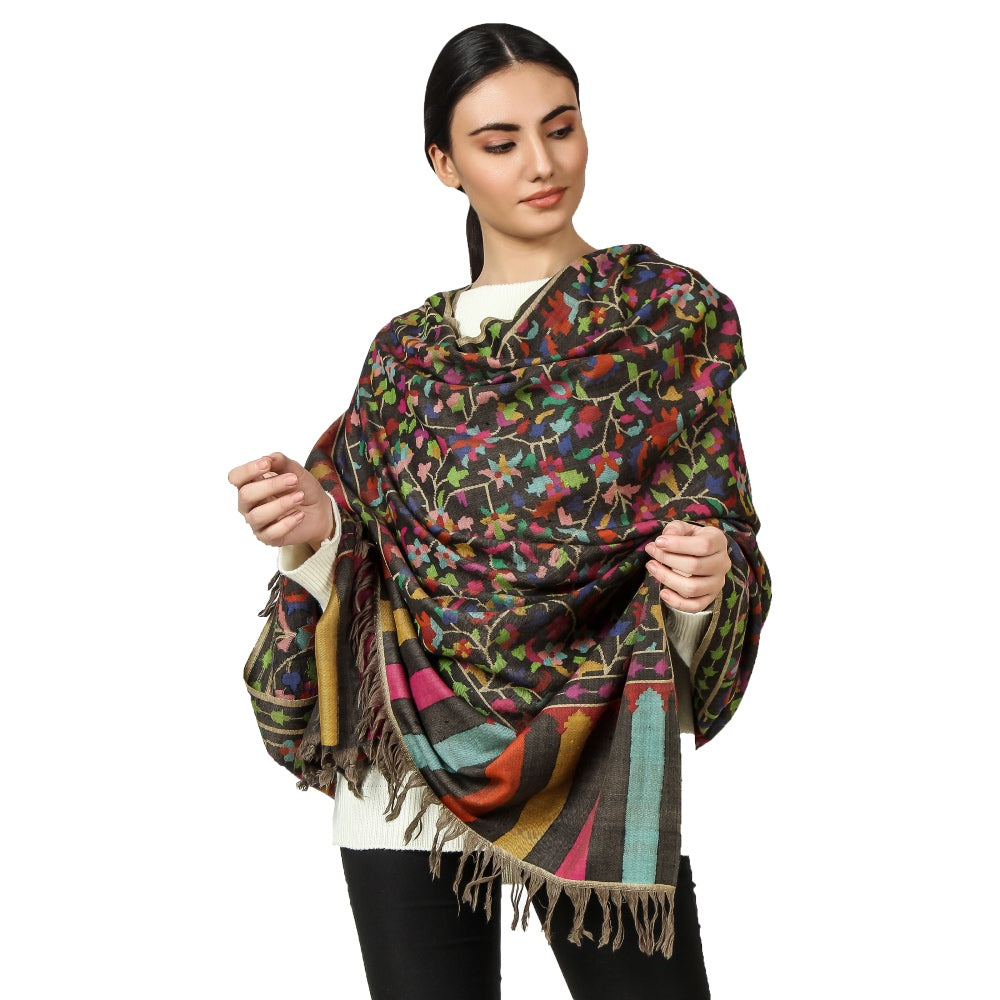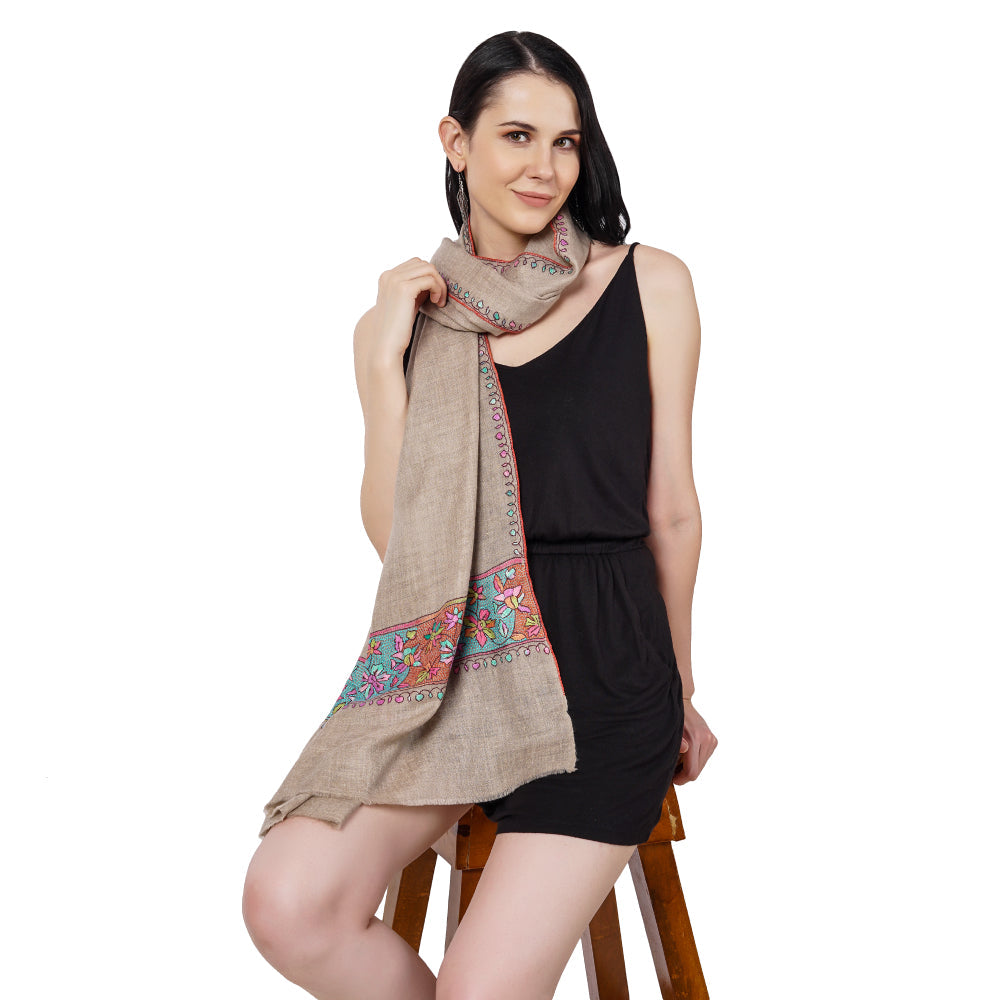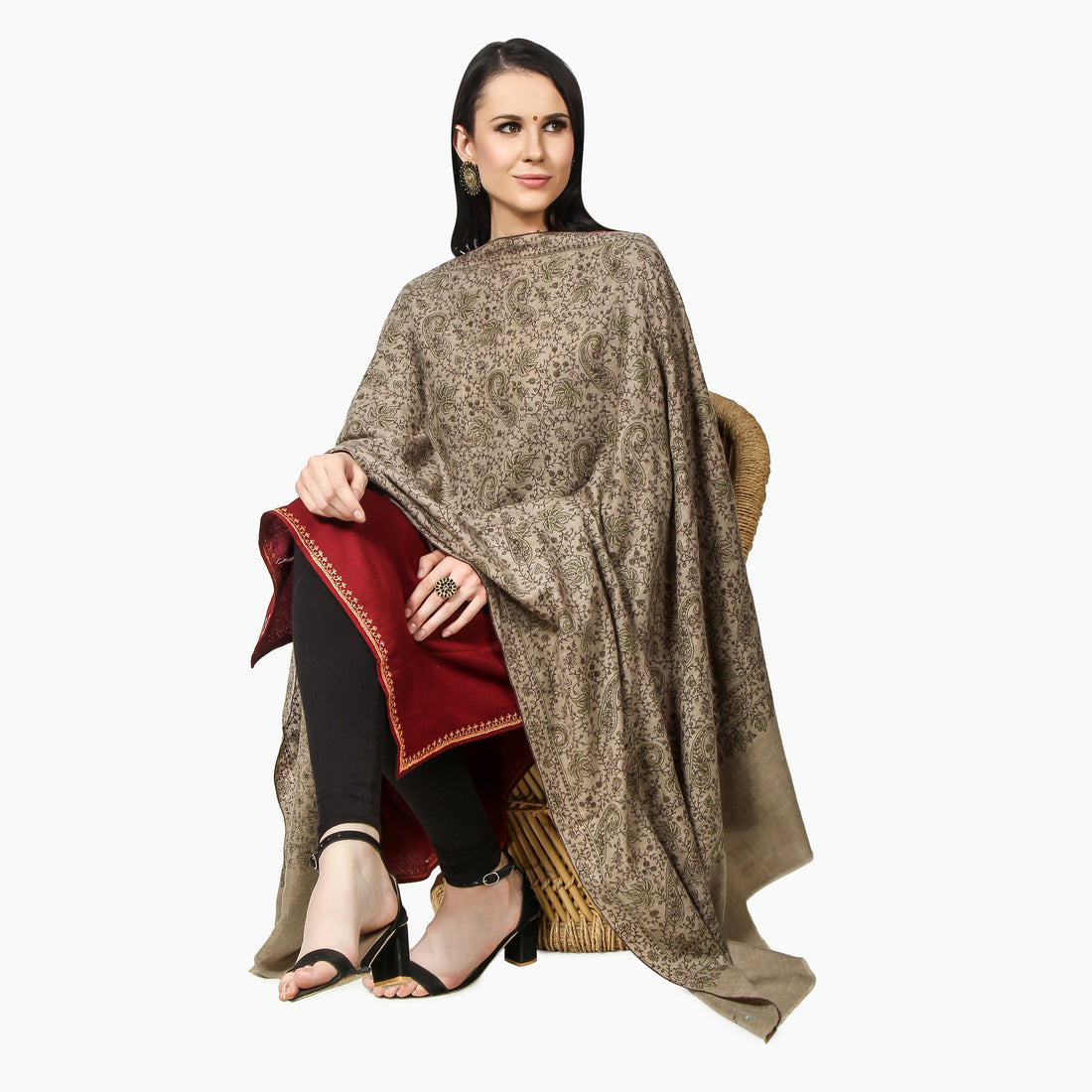
How do you wear a Pashmina to a Wedding
Share
WHAT IS PASHMINA
Pashminas are a type of fine woolen shawl that have been traditionally produced in the Kashmir region of India . They are known for their softness, warmth, and delicate texture, and are highly prized as luxury items. In recent years, Pashminas have become popular as fashion accessories, particularly for formal occasions like weddings.
Pashminas are a good accessory for weddings because they can add an elegant touch to any outfit while also providing warmth and comfort. Many weddings take place in the colder months of the year, and Pashminas can help guests stay cozy without sacrificing style. Additionally, Pashminas come in a variety of colors and patterns, making it easy to find one that complements your outfit and the wedding theme. Whether draped over the shoulders or wrapped around the neck, a Pashmina can elevate any wedding outfit and add a touch of sophistication to the occasion.
Types of Pashmina
Pashmina shawls are luxurious and delicate pieces of clothing that have been around for centuries. They are made from the fine wool of the pashmina goat, which is found in the Himalayan region. These shawls are known for their softness, warmth, and elegance, and have become popular fashion accessories all over the world. In this article, we will discuss five different types of pashmina shawls.
-
Solid Pashmina Shawl: Solid pashmina shawls are the most common and classic type of pashmina shawl. They are simple and elegant, with no pattern or design on them. They come in a wide range of colors, from the traditional black, white, and beige to brighter shades like pink, green, and blue. Solid pashmina shawls are versatile and can be worn with any outfit, making them a wardrobe staple for any fashion-conscious individual.

-
Embroidered Pashmina Shawl: Embroidered pashmina shawls are another popular type of pashmina shawl. They feature intricate embroidery designs on the edges or all over the shawl. These designs can be floral, geometric, or abstract, and are usually made using silk or cotton thread. Embroidered pashmina shawls are perfect for formal occasions or adding a touch of elegance to any outfit.

-
Kani Pashmina Shawl: Kani pashmina shawls are made using a unique weaving technique that involves using small wooden sticks to weave intricate designs into the fabric. This technique is called the kani method and is native to the Kashmir region. Kani pashmina shawls are known for their intricate designs and patterns, which often feature paisleys, flowers, and animals. These shawls are handmade and can take months to complete, making them a rare and valuable item.

-
Kalamkari Pashmina Shawl: Kalamkari pashmina shawls are made using a traditional Indian art form that involves hand painting or block printing designs onto the fabric. These shawls are usually made using natural dyes and feature intricate designs that often depict scenes from Hindu mythology or nature. Kalamkari pashmina shawls are a beautiful fusion of Indian and Kashmiri art and are perfect for those who want to make a bold fashion statement.

-
Jamawar Pashmina Shawl: Jamawar pashmina shawls are known for their intricate paisley designs and are made using a traditional Kashmiri weaving technique. These shawls are usually made using silk and pashmina wool and can take months to complete. The paisley designs are created by weaving small threads of different colors into the fabric, creating a stunning and intricate pattern. Jamawar pashmina shawls are luxurious and perfect for special occasions.

Also read: The benefits of owning a Pashmina Shawl
Choosing the Right Color
Pashminas come in different types of materials, including wool, silk, and blended fabrics. Wool Pashminas are the most common and are made from the fine undercoat of the cashmere goat. They are soft, lightweight, and warm, making them perfect for colder weather. Silk Pashminas, on the other hand, are made from a blend of silk and cashmere fibers, and are known for their softness and lustrous sheen. They are a great choice for warmer weather or for dressing up an outfit.
The type of Pashmina you choose can affect how it should be worn. Wool Pashminas, for example, are best worn draped over the shoulders or wrapped around the neck, while silk Pashminas can be worn in a variety of styles, including as a scarf or shawl. Blended Pashminas, which are made from a combination of wool and silk or other fibers, offer the best of both worlds, combining the warmth and softness of wool with the sheen and draping qualities of silk.
It's important to consider the type of Pashmina when choosing an outfit for a wedding. A wool Pashmina, for example, may be too warm for a summer wedding, while a silk Pashmina may not provide enough warmth for a winter wedding. Additionally, the texture and weight of the Pashmina can affect how it drapes and how it complements your outfit. A heavier Pashmina may be better suited for a formal evening wedding, while a lighter Pashmina may be better for a daytime or outdoor wedding. By considering the type of Pashmina and how it should be worn, you can choose the perfect accessory to complete your wedding outfit.
Also read: Which is the most expensive wool in the world.
How to Drape a Pashmina
Choosing the right color for your Pashmina is important to ensure that it complements your outfit and the overall wedding theme. When selecting a color, it's essential to consider the color scheme of the wedding and choose a Pashmina that complements it. For example, if the wedding colors are navy and gold, consider choosing a Pashmina in a complementary color like burgundy or cream.
It's also important to consider your own outfit when choosing a Pashmina color. If your outfit is a solid color, you can choose a Pashmina in a complementary color or pattern that adds interest to your look. If your outfit already has a pattern or multiple colors, it's best to choose a solid color Pashmina that complements one of the colors in your outfit.
When choosing a Pashmina color, consider your skin tone as well. Certain colors may be more flattering on different skin tones. For example, warm colors like reds, oranges, and yellows can be particularly flattering on people with warm skin tones, while cool colors like blues and greens may be better suited for people with cooler skin tones.
Ultimately, choosing the right color for your Pashmina depends on your personal style, the wedding theme, and your outfit. By considering these factors and taking the time to choose a complementary color, you can ensure that your Pashmina adds the perfect finishing touch to your wedding look.
Draping a Pashmina can add an elegant touch to any wedding outfit. Here are step-by-step instructions for two classic draping styles:
-
Drape Over the Shoulders:
- Start by holding the Pashmina lengthwise and folding it in half.
- Place the folded Pashmina over your shoulders, with the folded edge at the back.
- Take one end of the Pashmina and bring it over your shoulder, allowing it to drape down your back.
- Repeat with the other end of the Pashmina, bringing it over your other shoulder and allowing it to drape down your back.
- Adjust the Pashmina so that it drapes evenly over both shoulders, with the ends hanging down at the front.
Also read: How to drape a Pashmina Shawl around your Shoulder
-
Wrap Around the Neck:
- Begin by holding the Pashmina lengthwise and folding it in half.
- Place the folded Pashmina behind your neck, with the folded edge at the front.
- Take the two loose ends of the Pashmina and bring them to the front.
- Tie the ends of the Pashmina in a loose knot at the front, allowing the Pashmina to drape over your chest.
- Adjust the Pashmina so that it sits comfortably around your neck and shoulders.
To add variety to your Pashmina draping styles, consider experimenting with different knots or twists. You can also use accessories like brooches or pins to secure the Pashmina in place or add extra flair.
Also read: Adorn any occasion with Pashmina Shawls
Accessories to Pair with a Pashmina
When wearing a Pashmina to a wedding, choosing the right accessories can elevate your look and complete your outfit. Here are some suggestions for complementary accessories to pair with your Pashmina:
-
Earrings:
- Choose earrings that complement the color and style of your Pashmina.
- If your Pashmina has intricate embroidery or beading, consider wearing simple stud earrings to avoid overwhelming your look.
- If your Pashmina is a solid color, you can opt for statement earrings to add a pop of color or sparkle.
-
Bracelets:
- Delicate bracelets or bangles can add a subtle touch of elegance to your Pashmina look.
- Consider bracelets with small charms or stones that complement the color of your Pashmina.
- If you're wearing a sleeveless dress, you can choose to wear bracelets on both wrists for a balanced look.
-
Clutch:
- Choose a clutch that complements the color of your Pashmina and outfit.
- Consider a clutch with embellishments or details that match the style of your Pashmina.
- A small clutch can add a touch of sophistication to your overall look without being too distracting.
-
Shoes:
- Choose shoes that match the formality and color scheme of the wedding.
- Consider shoes with small embellishments or details that match the style of your Pashmina.
- If your Pashmina is a solid color, you can opt for shoes in a complementary color to add interest to your look.
When pairing accessories with your Pashmina, it's important to strike a balance between simplicity and statement pieces. Avoid overloading your look with too many accessories that may detract from the elegance of your Pashmina. By selecting complementary pieces that add subtle touches of sophistication, you can create a cohesive and stylish wedding look.
Dos and Don'ts of Pashmina-Wearing at Weddings
While Pashminas can be a great accessory for weddings, there are a few dos and don'ts to keep in mind to avoid fashion faux pas. Here are some tips:
Dos:
- Choose a Pashmina that complements your outfit and the wedding theme.
- Wear your Pashmina draped over your shoulders or wrapped around your neck for a sophisticated look.
- Consider using accessories like brooches or pins to secure your Pashmina in place.
- Experiment with different draping styles and knots to create unique looks.
- Wear your Pashmina as an accessory to your outfit, rather than letting it cover up your entire dress.
Don'ts:
- Don't let your Pashmina overwhelm your outfit. Choose a size and style that complements your dress rather than hiding it.
- Don't wear your Pashmina as a shawl. While it may be tempting to cover up in a chilly wedding venue, a shawl can look too casual for a formal event.
- Don't wear your Pashmina as a headscarf. While some cultures may wear headscarves to weddings, a Pashmina is not traditionally worn this way and can look out of place.
By keeping these dos and don'ts in mind, you can wear your Pashmina with confidence and create a stunning wedding look. Remember that the goal is to complement your outfit, not overshadow it. With the right Pashmina and accessories, you can create a stylish and elegant ensemble for any wedding occasion.
Conclusion
In conclusion, Pashminas can be a beautiful accessory for weddings that add an extra touch of elegance to your outfit. When choosing a Pashmina, consider the type, color, and style that will complement your dress and the wedding theme. You can experiment with different draping styles and accessories to create a unique look that fits your personal style.
Remember to avoid fashion faux pas by not letting your Pashmina overwhelm your outfit or wearing it as a shawl or headscarf. By following these tips, you can wear your Pashmina with confidence and create a stunning wedding look.
We encourage you to try wearing a Pashmina to your next wedding event. With their versatility and timeless style, Pashminas can be a wonderful addition to any formal occasion. So why not add some elegance to your next wedding ensemble with a beautiful Pashmina?

